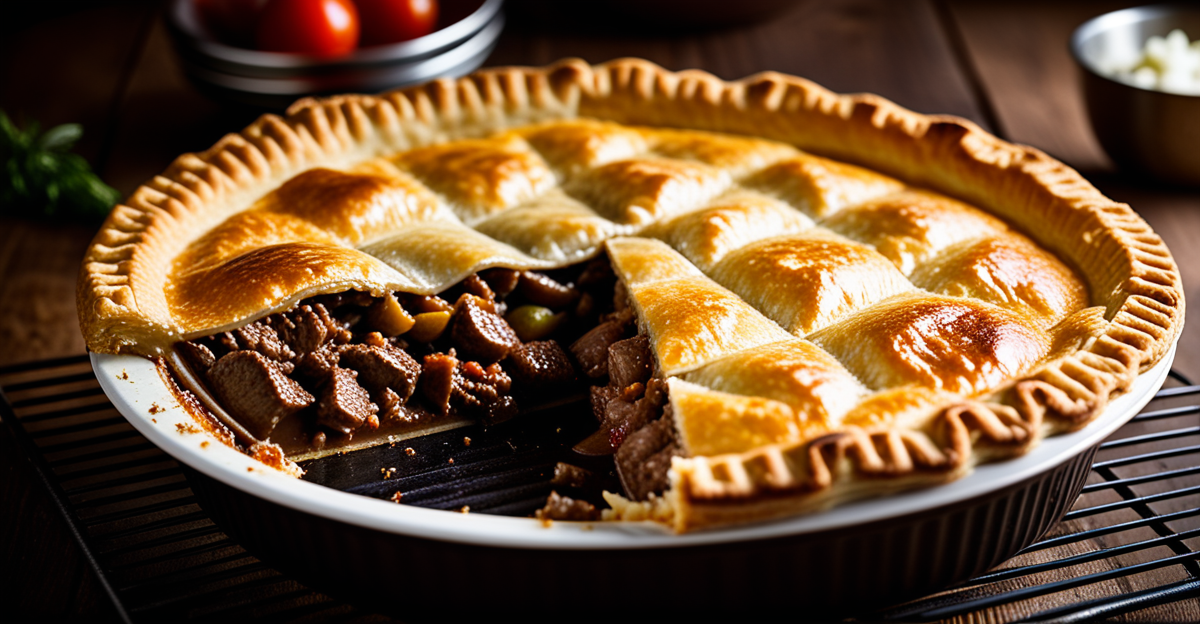Essential Ingredients and Tools for Homemade Steak and Kidney Pie
Choosing the right steak and kidney pie ingredients is fundamental for a rich, authentic flavor. High-quality, fresh beef steak and kidneys are paramount—the freshness of the kidneys especially impacts taste and texture. Tender steak cuts such as chuck or braising steak provide the ideal base, offering both flavor and moisture retention during cooking. Fresh kidneys should be thoroughly cleaned, removing membranes to avoid bitterness.
Pastry components are equally important. Use cold, unsalted butter combined with plain flour, and a pinch of salt to create a flaky, buttery crust. Cold water or occasionally egg yolks help bind the dough while keeping it tender. Seasonings like black pepper, salt, and a hint of thyme or bay leaves add depth without overpowering the filling’s natural richness.
Also to read : What are the must-try regional specialties in UK cuisine?
In terms of homemade steak pie tools, precision is crucial. Sharp knives for cutting meat and pastry cutters for shaping dough enable consistent results. A heavy-based pan or casserole is essential for browning and slow-cooking the filling evenly. Additionally, pastry brushes and pie dishes with good heat conduction ensure even baking and a golden crust.
Understanding these pie preparation essentials guarantees your homemade steak and kidney pie rises to professional standards, balancing taste, texture, and presentation.
Also to discover : What tips ensure a crisp and flaky fish and chips?
Preparing the Steak and Kidney Filling
Crafting a savory pie filling begins with meticulous steak and kidney preparation. Start by rinsing kidneys thoroughly to remove any bitterness, then trim away membranes and excess fat. Cut both steak and kidney into uniform bite-sized pieces, ensuring even cooking and a consistent texture in the filling.
Browning the meat is a critical step. Use a hot pan with a splash of oil to sear steak and kidney pieces until they develop a rich, caramelized crust. This process enhances flavor through the Maillard reaction, creating deep, savory notes fundamental to traditional steak pie techniques. Avoid overcrowding the pan, as this causes steaming rather than browning.
Once browned, combine the meat with aromatics such as finely chopped onions, garlic, and herbs. Adding beef stock gradually helps build a moist, flavorful environment for slow simmering. To thicken the filling, incorporate a roux or cornflour slurry—this ensures the filling’s body holds well without being too runny. Simmer gently until the meat is tender and the sauce has reached a luscious consistency.
Mastering these steak and kidney preparation steps is vital to developing a rich, hearty, and authentic pie filling that balances texture and flavor, fulfilling the expectations of classic steak and kidney pie ingredients.
Crafting Perfect Pie Pastry from Scratch
Creating a homemade pie crust that complements your steak and kidney pie filling requires attention to ingredient ratios and mixing techniques. The essential pastry components include cold, unsalted butter, plain flour, salt, and chilled water. Use a ratio of roughly 2 parts flour to 1 part butter by weight to achieve a tender, flaky pastry. Keep the butter cold and incorporate it into the flour using a cutting or rubbing method; this technique creates small butter pockets that melt during baking, producing a light texture in the savory pastry.
Chilling the dough is key. After mixing, wrap it and refrigerate for at least 30 minutes; this relaxes gluten, making rolling easier and preventing shrinkage during baking. When rolling, lightly flour the surface and roll evenly to avoid thin or thick spots that could cause uneven baking. For a professional finish, line your pie dish carefully, pressing gently into corners to prevent gaps that cause leakage.
Using homemade pie crust not only delivers a golden pie crust but enhances your steak and kidney pie by balancing richness without overpowering the filling. Following these flaky pastry tips ensures pastry integrity, adding crispness and structure to your traditional favorite.
Essential Ingredients and Tools for Homemade Steak and Kidney Pie
Selecting top-quality steak and kidney pie ingredients is the first step toward a satisfying homemade pie. Fresh steak, preferably chuck or braising cuts, offers tenderness and flavor depth. Kidneys must be fresh and well-cleaned to prevent bitterness, a common pitfall impacting taste. Pastry components also require quality ingredients: cold, unsalted butter and plain flour are key to a flaky, golden crust that contrasts perfectly with the rich filling.
When it comes to homemade steak pie tools, precision matters. A sharp knife ensures clean cuts for even cooking, while a heavy-based pan or casserole provides steady heat necessary for browning and slow simmering. Pastry brushes assist in glazing, helping develop a golden crust. Reliable pie dishes with good heat conduction promote even baking and prevent soggy bottoms—critical pie preparation essentials often overlooked.
Proper tools combined with premium ingredients streamline the cooking process and significantly elevate the final steak and kidney pie. Investing time in sourcing fresh meats and using dedicated kitchen tools guarantees a pie that meets traditional standards both in flavor and texture.
Essential Ingredients and Tools for Homemade Steak and Kidney Pie
Selecting the finest steak and kidney pie ingredients is vital for a successful dish. Freshness directly impacts both flavor and texture, especially with kidneys, which should be thoroughly cleaned to reduce bitterness. Choose tender beef cuts like chuck or braising steak for their marbling and ability to remain juicy after slow cooking.
Pastry components also demand quality: cold, unsalted butter and plain flour form the foundation of flaky, golden pastry. Using fresh, quality seasonings such as black pepper, thyme, and bay leaves enhances the filling without overshadowing the meat’s natural richness.
Equipped with the right homemade steak pie tools, you can perfect your pie preparation. A sharp knife ensures clean, uniform cuts necessary for even cooking. Heavy-based pans or casserole dishes provide stable heat essential for delicately browning and slow simmering the meat. Pastry brushes help apply glazes for that coveted golden crust, while pie dishes with good heat conduction prevent sogginess and uneven baking.
Mastering pie preparation essentials means prioritizing ingredient quality and using dedicated tools. This combination not only guarantees consistent results but elevates your homemade steak and kidney pie to traditional standards respected by enthusiasts and chefs alike.
Essential Ingredients and Tools for Homemade Steak and Kidney Pie
Selecting the highest quality steak and kidney pie ingredients ensures a flavorful and tender result. Freshness is crucial—especially with kidneys, which must be meticulously cleaned to eliminate bitterness and improve texture. Opt for cuts like chuck or braising steak, prized for their marbling and moisture retention during slow cooking.
The pastry components also play a vital role; cold, unsalted butter and plain flour yield a flaky, golden crust that perfectly balances the rich filling. Incorporate seasonings such as black pepper and bay leaves sparingly to highlight, not mask, the meat’s depth.
Utilizing appropriate homemade steak pie tools streamlines the cooking process. A sharp knife enables precise, uniform cuts, essential for even cooking and texture consistency. Heavy-based pans or casserole dishes provide stable heat for browning and slow simmering, preventing burning or uneven cooking. Pastry brushes enhance crust appearance by aiding in glazing, while well-conducted pie dishes promote even baking and discourage sogginess.
Together, focusing on premium steak and kidney pie ingredients and dedicated pie preparation essentials allows for a robust and authentic steak and kidney pie, balancing flavor, texture, and visual appeal. These efforts elevate homemade pies to professional culinary standards.










